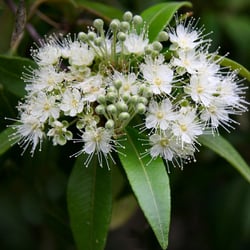"ANTIBACTERIAL" AS A TOP COSMETIC TREND
With risks of COVID-19 still strongly in consumers' minds, personal hygiene still holds strong. The product claim ‘antibacterial’ continues to dominated new product launches for the Soap, Bath, and Shower (SBS) category. Notably, there has been a rise in antibacterial claims across most SBS sub-categories. MINTEL recommends adding value to hygiene-focused SBS innovation with additional functionality to maintain a longer-term interest.
We have detailed the Top 10 Trends in Beauty and Personal Care including data from MINTEL, and matched these trends with Down Under Enterprises’ extensive range of native Australian botanicals to help you conceive your own distinctive product attributes in alignment with your brand. Antibacterial or Antimicrobial is Trend 7 out of 10 global cosmetic trends.
Click HERE for the Top 10 Global Cosmetic Trend White Paper.
MINTEL data indicates that even as fears over COVID-19 interest in antibacterial, or antimicrobial will continue to hold strong consumer appeal.
TOP PICKS FOR ANTIMICROBIAL POTENTIAL
Australian Tea Tree Oil offers formulators many functional benefits. Hundreds of peer-reviewed, published data documents its antiviral, anti-inflammatory, antifungal and antibacterial properties.
Tea Tree Oil has demonstrated sanitizing efficacy equal to or greater than alcohol in a randomized controlled trial conducted in accordance with FDA Guidelines for Hand Sanitizers.[i] In another study comparing 2.0% Tea Tree Oil (TTO) against 0.5% triclosan and 2.0% chlorhexidine, all the three products demonstrated significant antimicrobial action. The study comprised of healthcare workers, who noted the pleasant aroma and non-dryness of their skin when using the soap containing Tee Tree Oil.[ii]
When sourcing Tea Tree Oil, make sure it complies with ISO4730:2017 and is accredited by the Australian Tea Tree Industry Association's Code of Practice Quality Control program.
Down Under offers a series of WHITE PAPERS for each of these application areas, summarizing these scientific findings.
Learn more about the Anti-Viral Mechanism of Tea Tree Oil.
Do not be fooled by the name, this aromatic Aussie native is not even of the same botanical genus as the well-recognized Tea Tree Oil (Melaleuca anternifolia). The essential oil derived from Lemon Scented Tea Tree Oil (Leptospermum petersonii) is rich in uplifting citrals.
Lemon Scented Tea Tree Oil (TTO) works wonderfully well in a variety of products given its antimicrobial properties and delightful scent. It can be used to mask the strong aroma of Tea Tree Oil, achieving a synergistic antimicrobial boost as well.
With its refreshing and on-trend citrus aroma, Lemon Scented Tea Tree can be used in combination with Tea Tree Oil to disguise the aroma of Tea Tree. Researchers at Macquarie University in Australia found Lemon Scented Tea Tree Oil to have to have an MIC and MBC of less than or equal to 0.12 % against aureus. Furthermore, the addition of Lemon-Scented Tea Tree Oil in a 1:5 ratio to Tea Tree Oil increased the microbiological activity of Tea Tree Oil alone by 4-fold (MIC 1% dropped to 0.25% with the combination). Lemon Scented Tea Tree Oil has been more widely researched for its anti-fungal potential. At a concentration of 0.2 mg/ml, Lemon Scented Tea Tree was more than 90% effective against the dermatophytes Microsporum canis (KCTC 6591), Trichophyton mentagrophytes (KCTC 6077), and Epidermophyton floccosum (KCCM 11667).[iii]
Learn more about Lemon Scented Tea Tree Oil.
While many people are familiar with Manuka Honey, the new Manuka Oil is demonstrating its own unique therapeutic properties. Manuka Oil is an essential oil, steam distilled from the leaves of the scrub tree Leptospermum scoparium, native to both New Zealand and Australia. It is the same plant from which bees make Manuka Honey.
Manuka Oil is a highly effective natural ingredient when formulating for Personal Care anti-bacterial products, including body washes and deodorants. Manuka Oil has demonstrated particularly strong antibacterial activity against gram-positive bacteria including Staphylococcus aureus and Staphylococcus hominis in microbiological testing for Minimum Inhibitory Concentrations (MIC) and Minimum Bactericidal Concentrations (MBC)[iv]. Manuka Oil’s natural affinity for targeting gram positive Staph bacteria was put to the test in a comparison with Manuka Honey and Tea Tree Oil. Unsurprisingly, the MIC result for Manuka Oil was significantly lower at 0.0156% compared to Manuka Honey (UMF 20+) with a MIC of 0.626% and Tea Tree Oil with a MIC of 1% against aureus.[iv]
While Manuka Oil is significantly more potent against gram-positive bacteria, Tea Tree Oil is stronger against gram-negative bacteria, fungi, and viruses. Together they make up our Dynamic Duo!
Read more in our White Paper: Applications of Manuka Oil in Personal Care.
Eucalyptus Yandee™
Eucalyptus Yandee (Eucalyptus loxiphleba lissophloea) Essential Oil is the Eucalyptus you have never before experienced. Imagine an all-natural eucalyptus aroma but with a fresh and uplifting twist of fruity sweetness – pears, apples – perhaps even a hint of peach.
While Yandee Oil is comprised of ~75% Eucalyptol (1,8 cineole), the similarities with common Eucalyptus end there. According to aromatherapy and Australian essential oil expert Mark Webb, Yandee exhibits a fresh and minty fragrance with striking – and surprising – green apple and grass notes. Mark goes on to say, “Yandee is very, very soft and nice”.
.jpeg?width=250&height=375&name=CGA_Yandee_A38I8710_lr%20(1).jpeg)
Eucalyptus Yandee shares much of the same 'good news' environmental story as Eucalyptus Kochii Oil (Eucalyptus kochii, ssp plenissima). Planted in intercropping rows with large wheat fields, these two species are largely responsible as saviors of the local environment, using their 20+ meter roots to draw down the water table and reduce soil salinity levels.
Eucalyptus Kochii
Eucalyptus Oil has a fresh and pleasant aroma and as such is a popular ingredient in personal care and home care products. The leaves of the Eucalyptus tree contain the essential oil which provides these benefits.
Eucalyptus Kochii offers the highest known concentration of 1,8-Cineole – Eucalyptol – of any Eucalyptus species, over 92%, far exceeding the natural Eucalyptol concentration of ~65% for Eucalyptus Globulus.

The synergistic effects of essential oils are an area of considerable scientific interest. When used in combination, or to enhance the performance of synthetic ingredients[v], Eucalyptus oil and its main constituent, Eucalyptol (1,8-cineole) has also been studied for its antimicrobial efficacy in combination with other antimicrobials, including chlorhexidine digluconate (CGH).
CGH is a disinfectant and antiseptic that is commonly used to sterilize surgical instruments.
Synergistic activity was favorably demonstrated between CHG and both Eucalyptus Oil and 1,8-cineole against suspensions of Staphylococcus aureus, methicillin-resistant S. aureus (MRSA), Escherichia coli and Candida albicans, and biofilm cultures of MRSA and Pseudomonas aeruginosa.[v]
Lemon Myrtle Oil
Lemon Myrtle (Backhousia citriodora) has been described as more lemon than lemon!
Lemon Myrtle is an ideal hero ingredient for hand sanitizers and handwash with its fresh citrus aroma fragrance and strong antimicrobial properties. Lemon myrtle oil was shown to possess significant antimicrobial activity against a broad spectrum of organisms – bacteria (gram positive and negative), fungi, and yeasts – including Staphylococcus aureus, Escherichia coli, Pseudomonas aeruginosa, Candida albicans, methicillin-resistant S. aureus (MRSA), Aspergillus niger, Klebsiella pneumoniae and Propionibacterium acnes comparable to its major component citral. Lemon Myrtle Oil’s safety and efficacy has been established at 1% concentration.[vi]

At each tested level, 0.5x, 1x and 2x base MIC concentration, Lemon Myrtle Oil demonstrated significant inhibitory efficacy, comparable with streptomycin, against each bacteria strain.
An earlier study published in 2003 showed significant antimicrobial properties of Lemon Myrtle Oil. The in-vitro study tested Lemon Myrtle Oil against 13 bacteria, including MRSA, and 8 fungi in comparison with other essential oils. Lemon Myrtle Essential Oil demonstrated stronger antimicrobial efficacy than citral alone and Tea Tree Oil.
Kunzea Oil
This little-known essential oil is produced from a native botanical called Kunzea ambigua. The plant biomass is wild-harvested year-round throughout Flinders Island – a small and remote, wind-swept island off the northeast coast of Tasmania. Therapeutically, Kunzea Oil may aid in supporting treatment for many ailments but is said to have superior efficacy as a topical anti-inflammatory for joints and sore muscles. Kunzea Oil has low/no skin sensitivity concerns, and yields a clean, fresh, and invigorating scent.

Researchers from the University of Canberra have reported on Kunzea Oil offers great potential as an effective alternative to current active ingredients contained within commercial pediculicide formulations. In their research, head lice were exposed to filter paper treated with either Kunzea Oil, at either a 5% or 100% oil concentrations, as well as commercial formulations containing either Permethrin or Tea Tree Oil (TTO) and measured at 30, 60, 90, and 120 minutes.
Notably, adult head lice exposure to Kunzea Oil, at 5% reached 100% mortality within 30 minutes, which was faster acting than either TTO or Permethrin.
The researchers propose that botanical extracts avoid the problems arising from residual effects seen with synthetic pediculicides. Kunzea Oil, and other botanicals are highly unlikely to yield resistance in lice because of multiple modes of action of each of their active principles.











web-1.png?width=248&height=350&name=Lemon%20Scented%20Tea%20Tree%20(Leptospermum%20petersonii)web-1.png)

_LR-1.png?width=281&height=398&name=Manuka%20(Leptospermum%20scoparium)_LR-1.png)




